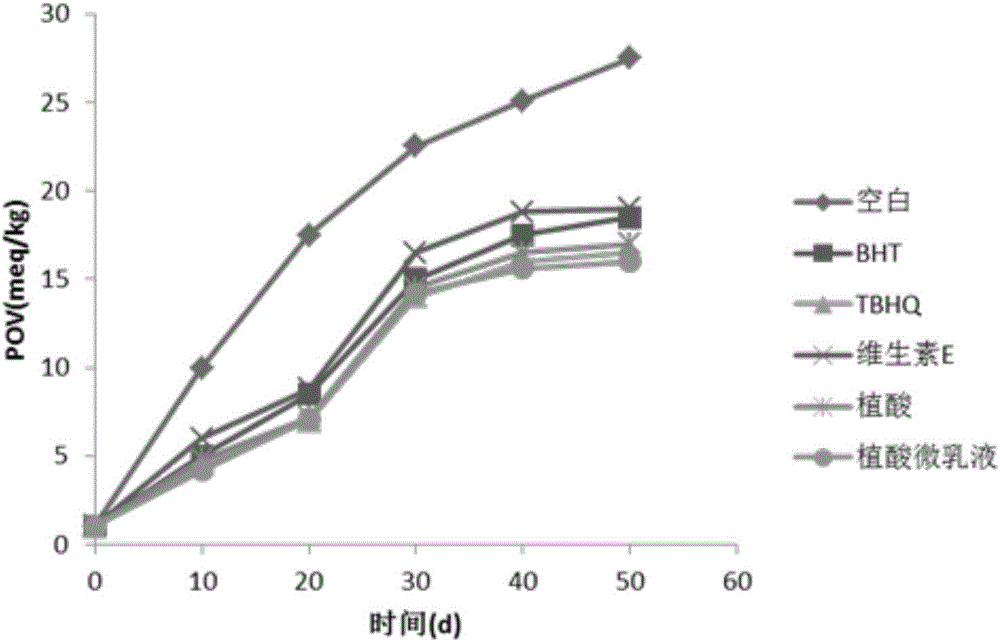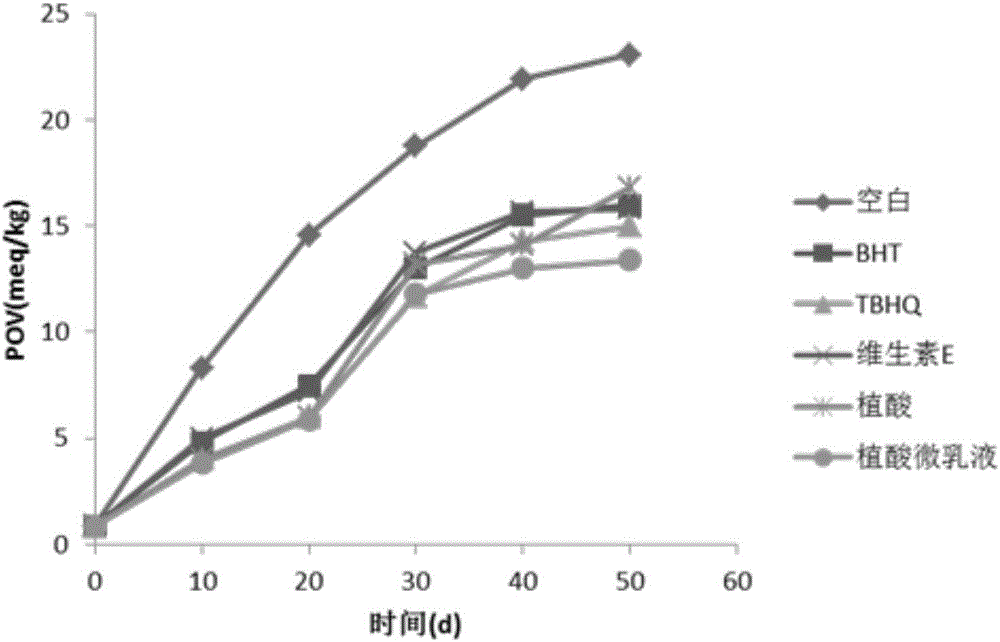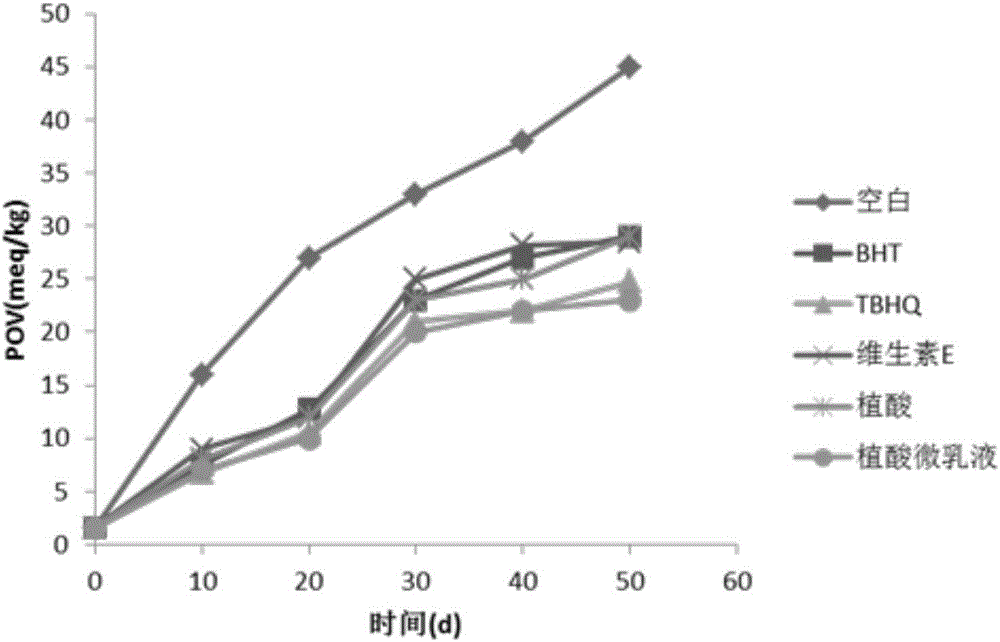Preparation method and application of phytic acid water-in-oil micro-emulsion
A microemulsion and water-in-oil technology, which is applied in the direction of using additives to preserve fat substances and generate fat, can solve the problems of not being easy to add antioxidants, poor solubility, and low transparency, so as to improve the anti-oxidation effect and strong anti-aging Oxidation effect, effect of expanding application range
- Summary
- Abstract
- Description
- Claims
- Application Information
AI Technical Summary
Problems solved by technology
Method used
Image
Examples
Embodiment 1
[0035] 1. Preparation of phytic acid solution:
[0036](1) crushing the rice bran through a 40-mesh sieve, degreasing 3 times with petroleum ether or n-hexane, drying the solvent after evaporation to obtain defatted rice bran powder;
[0037] (2) Mix the defatted rice bran powder and deionized water according to the mass ratio of 1:5, the pH value is 6, use the flat filter membrane with a molecular weight cut-off of 5kDa to simultaneously extract the rice bran protein and rice bran polysaccharide, and collect the rice bran residue after filtration;
[0038] (3) Use 1% aqueous acetic acid solution as a solvent for the obtained rice bran residue, stir and extract at room temperature for 1, centrifuge at 6000r / min for 30min, and collect the supernatant; pass the obtained supernatant through anion exchange resin adsorption chromatography, and use 0.1 mol / L sodium chloride aqueous solution was used for elution, and the eluate was collected, desalted with cation exchange resin, and ...
Embodiment 2
[0043] 1. Preparation of phytic acid solution:
[0044] (1) crushing rice bran through a 60-mesh sieve, degreasing 3 times with petroleum ether or n-hexane, drying the solvent after evaporation to obtain defatted rice bran powder;
[0045] (2) Mix the defatted rice bran powder and deionized water according to the mass ratio of 1:15, the pH value is 8, use the hollow fiber filter membrane with a molecular weight cut-off of 100kDa to simultaneously extract the rice bran protein and rice bran polysaccharide, and collect the rice bran residue after filtering;
[0046] (3) Use 3% acetic acid aqueous solution as a solvent for the obtained rice bran residue, stir and extract at room temperature for 3 hours, centrifuge at 6000r / min for 30min, and collect the supernatant; pass the obtained supernatant through anion exchange resin adsorption chromatography, and use 1mol / L sodium chloride aqueous solution for elution, collect the eluate, desalt through cation exchange resin, and concent...
Embodiment 3
[0051] 1. Preparation of phytic acid solution:
[0052] (1) crushing rice bran through a 50-mesh sieve, degreasing 3 times with petroleum ether or n-hexane, drying the solvent after evaporation to obtain defatted rice bran powder;
[0053] (2) Mix degreased rice bran powder and deionized water according to the mass ratio of 1:10, and the pH value is 7. Use a flat filter membrane or a hollow fiber filter membrane with a molecular weight cut-off of 50kDa to simultaneously extract the rice bran protein and rice bran polysaccharide, and collect them after filtration rice bran residue;
[0054] (3) Use 2% acetic acid aqueous solution as a solvent for the obtained rice bran residue, stir and extract at room temperature for 2 h, centrifuge at 6000 r / min for 30 min, and collect the supernatant; pass the obtained supernatant through anion exchange resin adsorption chromatography, and use 0.5 mol / L sodium chloride aqueous solution was used for elution, and the eluate was collected, des...
PUM
| Property | Measurement | Unit |
|---|---|---|
| particle diameter | aaaaa | aaaaa |
| particle diameter | aaaaa | aaaaa |
| particle diameter | aaaaa | aaaaa |
Abstract
Description
Claims
Application Information
 Login to View More
Login to View More - R&D
- Intellectual Property
- Life Sciences
- Materials
- Tech Scout
- Unparalleled Data Quality
- Higher Quality Content
- 60% Fewer Hallucinations
Browse by: Latest US Patents, China's latest patents, Technical Efficacy Thesaurus, Application Domain, Technology Topic, Popular Technical Reports.
© 2025 PatSnap. All rights reserved.Legal|Privacy policy|Modern Slavery Act Transparency Statement|Sitemap|About US| Contact US: help@patsnap.com



